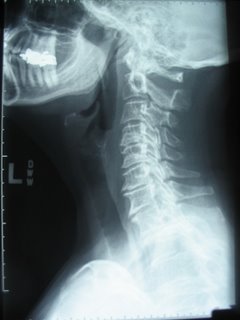To my Patients: I have a bone to pick with you!!
 Many of my patients, while lying on the table looking up at my face upside-down from their point of view ask me how I know just where to adjust them. In essence, how do I "pick the bone" that I'm going to adjust back into place. Is it an exact science or is there just some weird connection between a chiropractor's hands and the spine during that blissful moment when everything seems to magically "pop" back into place? When I answer the question, I am surprised to find that most patients tend to think it's the latter.
Many of my patients, while lying on the table looking up at my face upside-down from their point of view ask me how I know just where to adjust them. In essence, how do I "pick the bone" that I'm going to adjust back into place. Is it an exact science or is there just some weird connection between a chiropractor's hands and the spine during that blissful moment when everything seems to magically "pop" back into place? When I answer the question, I am surprised to find that most patients tend to think it's the latter. There are 3 main ways that we check for exactly which joint needs to be adjusted.
1) Static Palpation: Palpation means to feel with your hands. The neck, midback, and lower back spinal bones are all supposed to stack up one on top of the other. When you are lying on your back or stomach and it feels like we're pressing on each area, what we're feeling for is how the spine lines up in a relaxed neutral (static) body position. If we going along and suddenly feel one or two adjacent bones that feel slightly rotated to one side for example, our attention will then be drawn to that area for further investigation. Muscle tension along the sides of the spine is a major indicator of neighboring misalingment of the spine.
2) Dynamic Palpation: Once an area is of suspect, we then move to dynamic palpation which is feeling the position of a joint as it's moving. This can be accomplished by either pressing on the joint to hold it still while moving the rest of the body, or by feeling the bone as it moves with the body, such as when you are on your back and we move your neck to the left and right to determine the motion of the joints.
3) X-ray: Some areas of the spine sit so deep inside your body that we can roughly feel what the joints are doing, but sometimes there is an abnormal motion or history of injury, arthritis, or chronic pain and an x-ray is taken to visualize the status of the joints. Chiropractors take x-rays in a standing position because we want to see the effects of gravity on the joints. From the x-rays, we often see the deeper positions of joints that couldn't be felt from static or dynamic palpation. We often measure the angles between joints and evaluate where stress and gravity will effect the joints the most. Areas of high stress are targeted for adjustments to improve motion and flexibility. Obviously, we don't x-ray your spine on every visit, so we rely heavily on static and dynamic palpation.
Our goal is to narrow down the areas of misalignment or subluxation to a primary joint within each spinal area and differentiate it between other joints which are merely compensating for the primary joint. And as any patient knows, these areas are addressed with adjustments. Specific quick and shallow thrusts through the bone which is stuck restore its motion and allow normal nerve flow and proper reflexes.
Addicted to Crack? Let's face it; adjustments feel good. The reactions to adjustments range from a deep sigh of relief, to laughing, to clapping after it's done. Some people think that they can become addicted to the popping during the release of pressure during an adjustment that results in the improvement in motion and reduction of pain. While there is a slight endorphin release at the moment of adjustment, there is no known evidence of actual addiction to adjustments. The only addiction is in feeling normal again. Once you know what that feels like, you don't want to feel any other way again. Everyone has their own spinal patterns or idiosyncrasies which tend to mean that you will often be adjusted in similar areas depending on your need. But as you now know, we are always looking for the specific misalignments unique to you.


 y chiropractic treatments are enough?
y chiropractic treatments are enough? 



